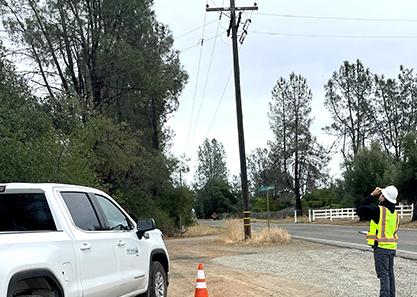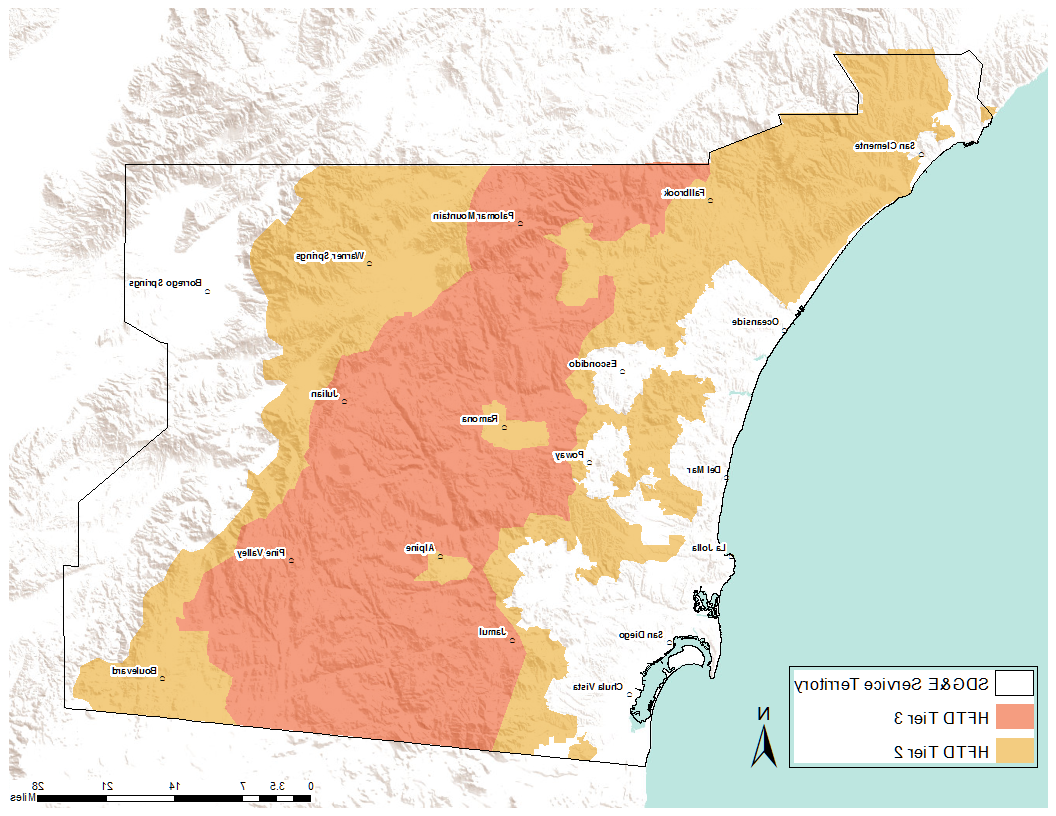Tree Safety and Vegetation Management
SDG&E prunes and removes trees and brush near electrical infrastructure to improve public safety and reduce the likelihood of power outages and wildfire.
What is vegetation management?

We begin with the Pre-Inspection of almost 500,000 trees located under and adjacent to powerlines. Each tree is inspected for safety and compliance every year. Pre-Inspectors also perform additional inspections requested by SDG&E customers, SDG&E field operations and others.

In addition to our annual Pre-Inspection, the SDG&E patrol team performs a second tree inspection in the High Fire Threat District (HFTD) annually. The HFTD has a higher fire risk due to the presence of electrical infrastructure, weather conditions, and areas of combustible vegetation and other fuels.

Tree pruning and removal are necessary to ensure safety, compliance and reliability. SDG&E is required to maintain minimum distances between vegetation and power lines. Fast-growing species and diseased or dying trees pose a special challenge when located near powerlines and may require extensive pruning or complete removal. Most cut limbs, branches and other green material associated with tree operations are ground into chips, diverted from landfills, and recycled as part of SDG&E’s Sustainability program.

Pole clearing is another vegetation management activity required as a fire prevention measure in the high fire risk area. It involves the removal of all vegetation within a 10-foot radius of poles that meet certain criteria. There are approximately 35,000 utility poles in this category.

SDG&E utilizes a third-party Quality Assurance team to perform audits on Vegetation Management activities including Pre-Inspection, Tree Pruning and Removal and Pole Clearing. Audit results provide key data on safety, compliance, and work quality.

SDG&E’s Fuels Modification Program is part of the company’s Wildfire Mitigation Plan (WMP). The program focuses on reducing the risk of point source wildfire ignitions in the High Fire Threat District and protecting the electric infrastructure.
What to Expect
If your property has overhead electrical power lines running through or near it, you may receive one or more visits by an SDG&E Vegetation Management contractor throughout the year. Please visit our FAQ below for more information about visits to your property.

You may see these SDG&E contractors working on your property:

Protecting Our Community
More details on how vegetation management works to keep our community safe.
Vegetation Management Overview
Line Clearance and Pole Clearing Information
Federal standards apply to clearances for transmission line rights-of-way
SDG&E High Fire Threat District
The SDG&E service territory is divided into three zones according to level of fire risk. Areas of elevated risk are referred to as High Fire Threat District (HFTD) Tier 2 (shown in gold). Inland areas with the highest risk are referred to as HFTD Tier 3 (shown in red).

Tree Planting Safety and Tree Programs
SDG&E has a variety of programs and rebates to help individuals and organizations seeking to add trees to their property. Visit our Community Tree Programs page for an overview of these programs.
You can also learn more about California’s vegetation management rules and regulations.
Vegetation Management Activities Schedule
Use the interactive map below to see when vegetation management crews are scheduled to work in your area.
- Click anywhere on the map and the schedule for that Vegetation Management Area (VMA) will pop up. You’ll see the three-digit number that identifies the VMA for that community, the tree pruning schedule and, in some areas, the pole brush schedule (for brush removal around power poles and transmission towers).
- You can also enter your address in the search box to pin your location, then click anywhere within your VMA boundary and the schedule will pop up.
- To change the look of the VMA map, click the icon below the zoom-in/out (+/-) buttons and choose one of 12 base maps.
Contact Us
If you’re concerned about vegetation growing close to a power line or transformer near your property, call our Customer Contact Center at (800) 411-7343 to request an inspection.
Frequently Asked Questions
When our Inspectors or Tree Crews require access to work on your property, they will provide advance notification, usually in the form of a phone call or a door hanger.
SDG&E contractors use vehicles marked with their own companies’ logos. Contractor personnel also carry employee identification issued by their company. If you’re ever unsure whether someone working on or around your property has a legitimate business purpose there, you can contact the contractor's office to verify.
- Clear Path Utility Solutions (715) 413-0103
- Davey Resource Group (858) 277-5860
- Rancho Tree Service (661) 735-7312
- Utility Tree Service (858) 798-5220
The general objective of tree pruning is to prune a tree’s branches so that it will remain in compliance with the minimum clearance requirements for the annual cycle. SDG&E will return to the same area the following year to inspect the trees for compliance. Generally, your tree will be pruned to a clearance of at least 10 feet from the power lines. Required clearances can be much greater due to growth, the presence of a hazardous condition or to achieve proper pruning cuts.
SDG&E prunes trees for safety, compliance, and tree health, not for aesthetics. Some trees are candidates for removal rather than pruning. There are several possible reasons. A tree may be a fast-growing species requiring continuous pruning, or it could be diseased, dying or pose a significant threat to the power lines.
All pruned branches smaller than approximately 5 inches in diameter are chipped into mulch on-site. The property owner has the option of keeping the mulch chips, or the contractor will haul them away. Tree branches and logs larger than approximately 5 inches in diameter are cut into rounds small enough to be moved and left on the property for use by the property owner.
We understand that property owners value their privacy. You’re likely to see a Pre-Inspector, who inspects each of the 500,000 trees along our power lines, every year. When tree pruning is required, the tree pruning contractor will notify a customer approximately 2-3 months after the inspection activity. If there are utility poles on your property that require clearing, you will also receive a visit from a Pole Clearing crew that clears a 10-foot radius around each pole down to bare mineral soil. This pole clearing work is often re-inspected and re-cleared more than once per year. You may also see Quality Assurance inspectors inspect a sampling of all work previously performed.
No. All tree pruning or removal work is done at no cost to the property owner.
